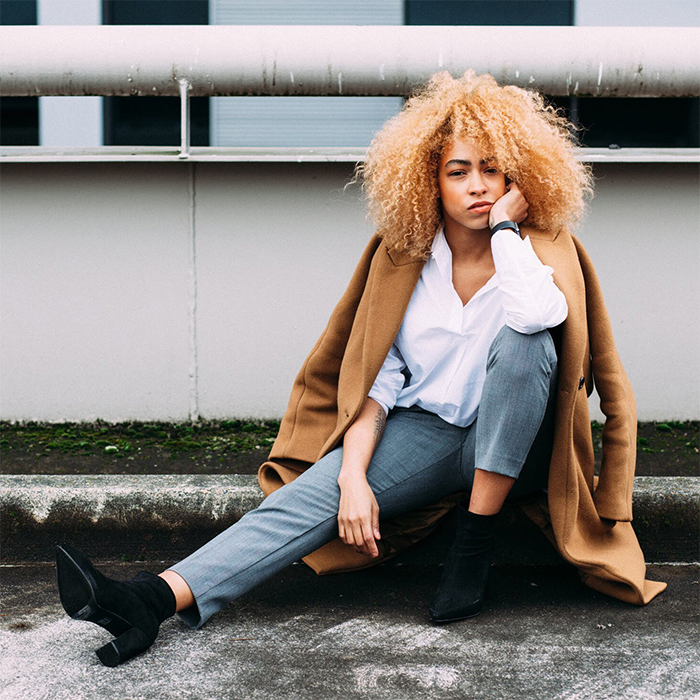Last week we talked about how to recover from damage by permanent color. Today we will discuss how to recover from bleach damage and heat styling tools.

Damage from bleach
If you’ve gone from dark to light hair, you probably know all too well the damage that bleach can inflict on your hair.
Bleach is used to remove your natural hair color from each strand through the process of oxidation. Oxidation decolorizes the pigment in your hair shaft. It makes your hair swell, allowing the bleach to reach the inner part of the strand. It literally dissolves the melanin that gives your hair pigment.
If left on too long, bleach will turn your hair almost white. Very bleached hair often gains a ‘yellow’ tint, because keratin (the protein your hair is made of”> is naturally a pale yellow tone.
Bleaching raises your hairs’ outer cuticle to allow the bleaching agent to fully penetrate. However, repeated bleaching can permanently raise the cuticle scales which allows rapid and continuous loss of moisture.
This process can leave hair dry, brittle, fragile, inelastic, porous, and more prone to breakage and split ends.
Bleached and chemically treated hair tends to be porous and can, therefore, have a higher affinity to conditioning ingredients because they have a low isoelectric point (meaning a higher concentration of negative sites”>.
How to recover and prevent further damage
- Bleach less frequently or not at all. There’s just no way around it. Bleach tends to damage your hair to some degree. The less you do it, the better.
- Professional colorist- Request a hair bond builder. These are formulated to protect hair from chemical damage and prevent further damage. Ex. Olaplex, Redken pH Bonder, Smartbond, and Karaal Baco powder lightener, just to name a few.
- Try to use permanent color with low ammonia content (ex: Bacò by Kaaral “>
- Add moisture by doing regular deep conditioning treatments. Before bleaching, pay extra attention to moisturizing your hair and avoid other damaging activities, like heat styling, for a couple of weeks.
- Use sun protection. The sun’s UV rays can harm your hair. Blonde and gray hair is especially susceptible to UV damage.
- During the hot months, try wearing a wide-brimmed hat or hair wrap to protect your hair and scalp. You can also use a UV protection hair spray (Ouidad Sun Shield Sun & Sport Leave-In or Phyto Phytoplage Protective Sun Veil“> to protect hair that peeks out.
Other Product Suggestions include:
- Olaplex no. 3
- Shea Moisture Jamaican Black Castor Oil Strengthen & Restore Leave-In Conditioner
- Ouidad Curl Immersion Triple Threat Deep Conditioner
- Deva Curl Melt into Moisture
- Deva Curl Deep Sea Repair
- Briogeo Don’t Despair Repair!
- The Curl Junkie Repair Me
- Aphogee Two Minute Reconstructor
- Giovanni Direct Leave-In Conditioner
Damage from using heat tools
Styling with heat can “cook” hair fibers and lead to raised cuticles and porous hair. If you’ve used heat styling tools on your hair for years, you might find that some sections have lost its elasticity, even after you wash your hair.
When you use high heat too often, over a prolonged period of time, your hair can lose its ability to curl or revert back to its natural texture due to the loss of elasticity caused by heat damage.
Hair that’s suffered considerable damage displays a few telltale signs: brittleness, loss of curl pattern, and breakage.
If this is the condition your hair’s in, you may be wondering if it’s possible to recover.
Everyone’s case is different and the length of time for recovery will vary. Sometimes it is possible for the hair to regain some movement, and sometimes, you’ll have to grow your hair out.
How to limit and prevent further damage
The first step to recovery is to clarify your hair to remove product buildup that can prevent moisture from getting into the hair.
Next, follow up with an application of a strengthening or conditioning mask or a combination of the two, depending on what your hair needs. Be careful not to overdo it—more isn’t always better, especially when it comes to protein treatments.
If you frequently use heat stylers, lower the temperature- the less heat you apply to your hair, the better. The reality is, if you continue using heat on your hair, especially while transitioning, you’re simply prolonging the process and setting yourself back.
The bottom line
Unless you have a time machine, you can’t undo hair damage once it’s done. But you can change your habits and give your hair some TLC.
If you aren’t seeing results after a few weeks, schedule an appointment with a professional stylist, where they can assess your damage and better advise you.
